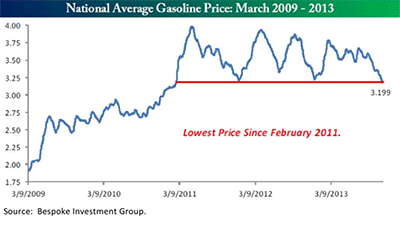“Who is Right on the Stock Market?”
by Jeffrey Saut, Chief Investment Strategist, Raymond James
November 18, 2013
If you’ve been wondering whether it’s possible to regularly beat the stock market averages – a natural question with the market at an all-time high – you didn’t get any guidance from the Nobel Prize committee this year: Two of the winning economists disagree on that perennial issue. In one corner is Robert Shiller, the Yale economist who argues that markets (and by implication, share prices) are often irrational and therefore beatable. He famously predicted the bubble in technology stocks in the late 1990s. In the other corner is Eugene Fama, the father of the view that markets are efficient and that they are always processing all available information. Mr. Fama’s followers believe that investors who try to beat the averages will inevitably fail. I get Mr. Fama’s theory, but the evidence points decidedly in the opposite direction. I have met many investors who have consistently outperformed the market. Take, for example, the world’s most famous – and most successful, if judged by personal net worth – investor, Warren Buffett. Mr. Buffett began an investment partnership in 1956 and, over the next 12 years, achieved a 29.5% compounded return, mainly by buying carefully selected stocks and then almost always holding them for a long period. In comparison, the Dow Jones Industrial Average rose by 7.4% per year during that same period.
... Steven Rattner, The Wall Street Journal (11/15/13)
Efficient, or inefficient, that is the key question. I would argue that at major inflection points the stock market is ANYTHING but efficient. That’s because, as my dear, departed father used to say, “The stock market is fear, hope, and greed only loosely connected to the business cycle!” Plainly, I agree and would note that when on March 2, 2009 I stated the stock market was going to bottom that week, I was greeted with cat-calls of disbelief. The same was true with the Dow Theory “sell signal” calls of September 1999 and November 2007. Currently my belief is that we are into a new secular bull market, which is drawing similar cat-calls from the negative nabobs of the investment community. What they continue to not understand is that the equity markets do not care about the absolutes of “good” and “bad.” All they care about is if things are getting “better” or “worse;” and things are definitely getting better. That said, my timing models have suggested caution on a short-term basis from mid-November into early December. Last week that strategy looked foolish, but I have repeatedly looked foolish over the past 43 years at various inflection points. And while nobody can consistently time the stock market, the astute observer can absolutely determine if they should be playing “hard,” or not be playing so “hard.” To be sure it is better to lose face and save skin in the investment business; or as Charles Dow wrote, “The successful investor needs to be able to ignore two out of every three money-making opportunities.”
Last week I chose to ignore the S&P 500’s move to new all-time highs because my instruments (the short-term timing models) suggested that caution is currently warranted. Just like flying an airplane in blacked-out conditions, one needs to trust the instruments, or run the risk of a major accident. In this business a “major accident” involves a substantial loss on investment capital. Beneath the ebullient dance of the Dow, however, there is a battle between good and bad. The bad is that mortgage interest rates are again rising (see chart on page 3), calling into question how impactful it will be on housing. The good is that gasoline prices are falling to their lowest level since February of 2011, which is tantamount to a huge tax cut for the American consumer. Interestingly, one month later, the five best performing macro sectors following a 10% decline in gasoline prices have historically been Consumer Discretionary, Transportation, Industrials, Financials, and Energy. Three months following such a decline in fuel prices it has been Consumer Discretionary, Financials, Technology, Energy, and Industrials. As far as some of the best performing stocks in the Russell 1000 from Raymond James’ research universe that perform the best after a 10% decline in gasoline prices, consider: Tempur Sealy International (TPX/$46.54/Strong Buy); Valero Energy (VLO/$43.00/Strong Buy); Lennar (LEN/$34.17/Outperform); Trinity Industries (TRN/$56.65/Outperform); Fleetcor Technologies (FLT/$118.20/Outperform); and Micron Technology (MU/$19.46/Strong Buy). Meanwhile, 58.6% of all reporting companies are beating their earnings estimates and 53.2% are beating their respective revenue estimates. This continues to suggest the S&P 500’s (SPX/1798.18) ~$107 earnings estimate for this year remains intact, likely implying next year’s ~$121 estimate is also achievable. If the SPX continues to trade at its current P/E ratio of 16.4x in 2014, the SPX’s target price become 1984 (16.4 x $121 = 1984) next year. That’s a long way above current prices!
So late last week I returned from Scottsdale, and last night from Key West, where I was seeing various accounts. In Arizona I was speaking at numerous events for our financial advisors and seeing institutional accounts. When I met with the portfolio managers (PM) for the state of Arizona, one particularly bright PM that embraced my theme of the election of smarter policymakers and therefore smarter policies over the next three to five years opined, “We are just one grand bargain from America regaining the world’s lead for the next 100 years;” and, I agree! Somewhat surprisingly, the faux pas of the Obamacare rollout may just lead to such a grand bargain! Verily, the so called “fumble” is a huge game changer in many ways. Lawyers I know, which are constitutional lawyers, do not think the President has the authority to pull the switcheroo he is currently trying to engineer. I actually feel like I am living in “Bizarro World,” where everything is “wired” backwards. How the government can tell us what kind of healthcare plan to buy is, well at best, weird. Also weird is the stock market’s recent action given the weight of the evidence suggesting cautious in the near-term.
The call for this week: The Advance/Decline Lines are not confirming the Dow’s new all-time high. Likewise, there is a lack of New Highs on the NYSE. Moreover, my timing models continue to suggest caution in the near term. Yet despite all the negative nabob’s comments, the weight of the evidence still points to higher prices and a healthy secular bull market in the years ahead. In the short-term, however, the stock market’s internal energy is totally used up. Last week’s decline in crude oil prices (-0.80%) sparked a rally in the Transports of 2.76% for the largest gain in any of the major indices. Meanwhile, the decline in gasoline prices drove a 2.54% advance in the Consumer Discretionary sector, a sector repeatedly favored in these reports. As for the question I posed at the beginning of this missive – is the stock market efficient or not – in yesterday’s New York Times another voice was heard from. This time it was Peter Hansen, a professor at the University of Chicago. He had this this to say, “A common theme in our work is that we’ve all characterized the puzzling implications that emerge from financial market data. But we take different approaches.” To which I say, “If markets were efficient J.P. Morgan (JPM/$54.87/Strong Buy) would have never traded at $15!”


















